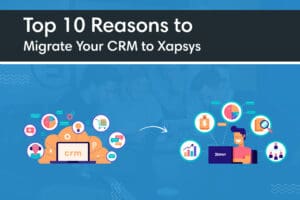Staying Ahead of the Curve: How Investing in Software Can Help Your Company Tackle Rising Costs
Published on 23 June 2023 by Chris Cox
Rising Costs in Business
In today’s competitive business landscape, rising costs have become a major concern for companies across industries. From increasing raw material prices to skyrocketing employee wages, businesses are constantly facing financial challenges that can impact their bottom line. In order to survive and thrive in this environment, it is crucial for companies to find ways to stay ahead of the curve and effectively manage these rising costs. One powerful solution that has emerged is investing in software. Explore the importance of staying ahead of the curve, how software can help businesses tackle rising costs, the types of software that can benefit businesses, and the cost-saving features of software.
The Importance of Staying Ahead of the Curve
Staying ahead of the curve is essential for businesses to maintain a competitive edge and navigate the ever-changing economic landscape. By proactively addressing rising costs, companies can avoid being caught off guard and mitigate the negative impact on their operations. It allows them to make informed decisions, adapt their strategies, and implement cost-saving measures before it’s too late. The ability to anticipate and respond to changing market conditions is crucial for long-term success. Investing in software provides businesses with the tools and insights needed to stay ahead of the curve and effectively manage rising costs.
How Software Can Help Businesses Tackle Rising Costs
Software has revolutionised the way businesses operate, offering a wide range of solutions to tackle rising costs. One key advantage of software is its ability to automate and streamline processes, reducing the need for manual labour and saving both time and money. For example, accounting software can automate financial tasks, eliminating the need for a dedicated accountant and reducing the associated costs. Similarly, inventory management software can optimise stock levels, minimising waste and avoiding unnecessary inventory carrying costs. By leveraging software solutions, businesses can achieve greater efficiency, reduce costs, and gain a competitive advantage.
Another way software can help businesses tackle rising costs is through data analysis and predictive analytics. With the right software tools, companies can gather and analyse vast amounts of data to identify trends, patterns, and potential cost-saving opportunities. For instance, customer relationship management (CRM) software can provide insights into customer behaviour, enabling businesses to optimise their marketing efforts and reduce customer acquisition costs. By harnessing the power of data, software empowers businesses to make data-driven decisions and implement targeted cost-saving strategies.
Types of Software that Can Benefit Businesses
There is a wide variety of software available in the market today, each designed to address specific business needs and challenges. Some of the key types of software that can benefit businesses in tackling rising costs include:
- Accounting Software: This type of software automates financial tasks such as bookkeeping, invoicing, and financial reporting, reducing the need for manual labour and minimising accounting costs.
- Inventory Management Software: This software helps businesses optimise their inventory levels, ensuring they have the right amount of stock on hand at all times, minimising carrying costs and avoiding the possibility of missing out on orders due to low stock.
- Project Management Software: Project management software enables businesses to plan, organise, and track projects efficiently, reducing the risk of delays and cost overruns.
- Customer Relationship Management (CRM) Software: CRM software helps businesses manage and analyse customer data, improving customer relationships, and reducing customer acquisition costs.
- Procurement Software: This software streamlines the procurement process, automating tasks such as supplier selection, purchase order generation, and invoice processing, leading to cost savings and increased efficiency.
Cost-Saving Features of Software
One of the main advantages of investing in software is the cost-saving features it offers. These features not only help businesses reduce costs but also improve overall efficiency and productivity. Some of the key cost-saving features of software include:
- Automation: Software can automate repetitive tasks, reducing the need for manual labour and saving time and money.
- Streamlining Processes: Software can streamline and optimise business processes, eliminating inefficiencies and reducing costs.
- Data Analysis: Software can analyse large volumes of data to identify cost-saving opportunities, optimize operations, and make data-driven decisions.
- Remote Work: With the rise of remote work, software enables businesses to reduce office space and associated costs while allowing employees to work from anywhere.
- Integration: Many software solutions offer integration capabilities, allowing businesses to streamline their operations by connecting different systems and eliminating data silos.
By leveraging these cost-saving features, businesses can significantly reduce their expenses and improve their financial performance.
Save Time and Money by Investing in Software Solutions
In today’s business landscape, staying ahead of the curve is crucial for companies to effectively manage rising costs and maintain a competitive edge. Investing in software provides businesses with the tools and insights needed to tackle these challenges head-on. By leveraging automation, data analysis, and cost-saving features, businesses can optimise their operations, reduce expenses, and drive growth. However, it is essential to carefully consider factors such as cost, scalability, integration, user-friendliness, and security when choosing the right software for your business. By following best practices during implementation and integration, businesses can successfully leverage software to stay ahead of the curve and navigate the complexities of rising costs. So, don’t wait any longer—contact Xapsys today and find out if we can help your business to save time and money!
Automate Processes
Automate repetitive tasks, such as order processing and inventory management, to save time and resources. Automation can also help reduce human errors and ensure that customers receive accurate and timely information about their orders.
Optimise Inventory Management
Regularly review and analyse your inventory levels to prevent stockouts or overstocking. Implement a demand forecasting system to predict future sales trends and adjust inventory levels accordingly. Efficient inventory management can help you maintain optimal stock levels, reduce costs, and enhance customer satisfaction.
Prioritise Customer Service
Excellent customer service is a key differentiator for small businesses competing with large corporations. By providing personalised, responsive, and high-quality customer support, small businesses can build strong relationships with their customers and foster loyalty.
Regularly monitor customer feedback and reviews to identify areas where your customer service can be improved. Respond promptly and professionally to both positive and negative feedback, demonstrating your commitment to addressing customer concerns and continually improving your service.
Optimise Your Workflow
An efficient workflow can help small businesses save time, reduce costs, and improve overall productivity. By streamlining processes and eliminating bottlenecks, small businesses can compete more effectively with large corporations.
Be Open to Change
Embrace change as an opportunity for growth and improvement. Continuously seek innovative ways to enhance your products, services, and processes, and be willing to adapt your business model to take advantage of new opportunities.
By leveraging CRM systems, streamlining order planning and management, utilising software solutions, prioritising customer service, optimising workflow, and continuously evaluating and adapting your strategies, your small business can successfully compete with large corporations and thrive in a competitive marketplace.


